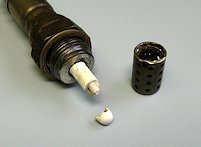Sensor Sensibility
Sensor Sensibility
 Oxygen sensors provide the feedback to keep emissions in check.
Oxygen sensors provide the feedback to keep emissions in check.
Motor Age — The world owes a debt of gratitude to the oxygen sensor. The air quality in our major centers has improved over the last several decades, despite significant population growth and millions more cars travelling on our nation’s road system.
Certainly, a host of technologies have helped to achieve the near-zero emissions of the modern automobile. However, many of these technologies would not have had the same impact (or might not have worked at all) without the feedback function provided by the oxygen sensor.
The oxygen sensor has experienced a metamorphosis of its own. From the earliest one-wire design in the mid-1970s to the latest wideband versions, oxygen sensors are more capable than ever of providing critical information to the vehicle powertrain management system. This increased capability has also benefited the diesel engine, as it has enabled the use of advanced diesel emission control technologies.
The Nernst Cell
 Most oxygen sensors (except for the relatively obscure titania sensor) operate on principles discovered in the late 1800s by Professor Walter Nernst. The basic oxygen sensor is a galvanic cell (better known as a Nernst Cell) made up of a gas-tight ceramic electrolyte sandwiched between two platinum electrodes. The ceramic electrolyte is composed of zirconia and yttrium, and is exposed to exhaust gas on one side and reference (atmospheric) air on the other. In the case of thimble sensor configurations, exhaust gases flow across the outer surface of the thimble and atmospheric air is on the inside.
Most oxygen sensors (except for the relatively obscure titania sensor) operate on principles discovered in the late 1800s by Professor Walter Nernst. The basic oxygen sensor is a galvanic cell (better known as a Nernst Cell) made up of a gas-tight ceramic electrolyte sandwiched between two platinum electrodes. The ceramic electrolyte is composed of zirconia and yttrium, and is exposed to exhaust gas on one side and reference (atmospheric) air on the other. In the case of thimble sensor configurations, exhaust gases flow across the outer surface of the thimble and atmospheric air is on the inside.
- Click here to read the complete article at Motor Age.
- Click here for more articles at Motor Age Online and to subscribe to their bi-weekly newsletter.
Source: Motor Age

